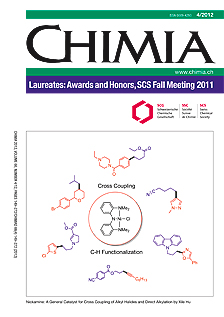Speed Limits for Acid–Base Chemistry in Aqueous Solutions
DOI:
https://doi.org/10.2533/chimia.2012.182Keywords:
Neutralization, O-nitrobenzaldehyde, Ph-jump, Ph-relaxation, Proton releaseAbstract
Proton transfer reactions, including acid–base recombination, are commonly considered to occur 'nearly instantaneously'. However, their actual time scales may stretch far into the microsecond range, as acid–base reactions are diffusion controlled and the concentrations are low near neutral pH. The interplay of competing bases in the pH relaxation is illustrated using a model acid–base system consisting of o-nitrobenzaldehyde (oNBA) as a proton cage and acetate ions and hydroxyl ions as bases. The kinetically controlled behavior leads to highly counterintuitive states, i.e. acetate ions are transiently protonated for hundreds of nanoseconds despite the presence of a much stronger base OH–.Downloads
Published
2012-04-25
Issue
Section
Scientific Articles
License
Copyright (c) 2012 Swiss Chemical Society

This work is licensed under a Creative Commons Attribution-NonCommercial 4.0 International License.
How to Cite
[1]
M. L. Donten, J. VandeVondele, P. Hamm, Chimia 2012, 66, 182, DOI: 10.2533/chimia.2012.182.







